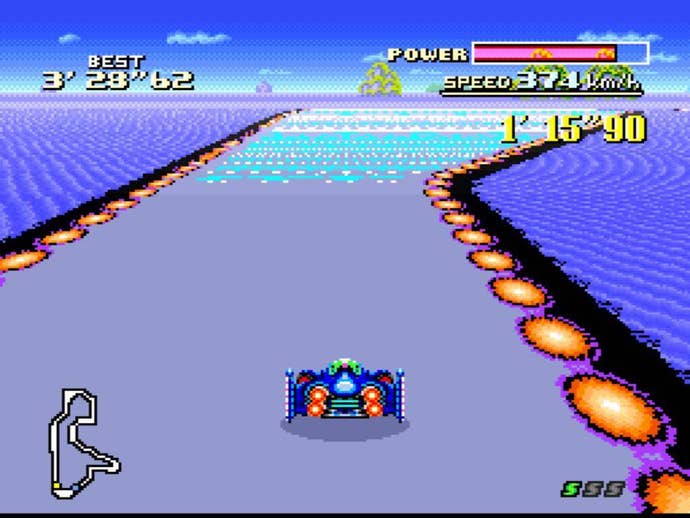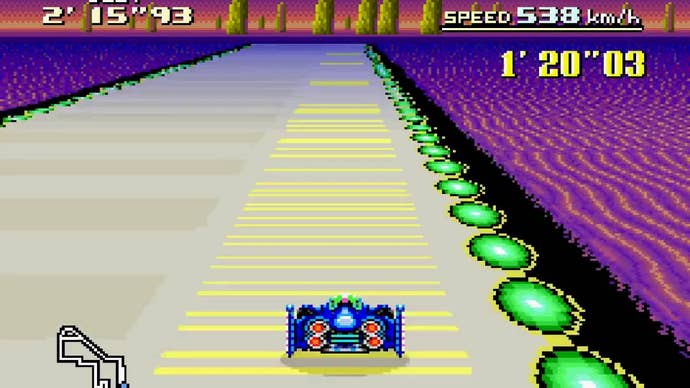Super NES Retro Review: F-Zero
Join us as we review every Super NES Classic game. Second in the queue: The game that taught Captain Falcon to fly.
This article first appeared on USgamer, a partner publication of VG247. Some content, such as this article, has been migrated to VG247 for posterity after USgamer's closure - but it has not been edited or further vetted by the VG247 team.
Join us as we review all the games on the SNES Classic Mini Edition in chronological order!
It's fun to think back to Captain Falcon's subdued birth on the SNES. When F-Zero came to North America in 1991, Falcon still was years away from "FALCON! PAAAAUNCH!"-ing his way into our hearts in the Smash Bros franchise.
There is no spandex-flashing tomfoolery in F-Zero, however. The Captain keeps his arms and legs inside the Blue Falcon at all times. F-Zero's Grand Prix requires razor-sharp concentration and reflexes, and one wrong move sends you plummeting off the edge of Highway Mode-7. You either race, or you die.
Most Nintendo games are built with rock-solid foundations that are engineered to hold up for ages, and that holds true for F-Zero. This racing game, painted in all the colors of the late '80s, isn't feature-rich – but its basic content stretches out for miles and offers hours of intense play. Once that snazzy title screen pops up and almost immediately fires up a demo of what you're in for, you're helpless to avoid pressing "START." Within seconds – and after you're introduced to the course by diving at it from the sky – you're ripping around Mute City and tapping your toe to its enthralling theme.

Then you move on to Big Blue. And Sand Ocean. And so on. F-Zero is like a bag of Regular-flavored potato chips; at first glance, you believe you'll tire of it quickly, but that crispy, salty flavor quickly becomes hard to turn away from. Before you know it, you're stuffing handfuls into your mouth.
F-Zero only has nine tracks spread across three leagues, but Nintendo squeezes life out of them in a clever way: The courses you re-visit open detours that contain tighter roads, sharper curves, and deadlier hazards. Each course has its own personality, too. Mute City's wide roads make for a decent tutorial stage. Big Blue's slippery roads and wide turns make staying at the head of the pack difficult. Death Wind buffers your car with strong winds, Silence (it's not silent) is fraught with 90-degree turns, and Port Town is pocked with huge gaps in its road.

In other words, F-Zero is deeper than it lets on. Not only does each course take a ton of practice to master, but each of the four hovercars you can choose from have very clear strengths and weaknesses. The speedometers on F-Zero's cars often read 400 km/h or above, and by gosh, that sense of speed is genuine thanks to that Mode-7 magic. It's incredibly easy to lose control of your vehicle and bounce between a course's barriers like a Pong ball. If you take too much damage, your hovercar goes kaboom in a very loud explosion that's capable of sending little kids running out of the room, crying (I know this from experience).
Though it's never explicitly stated, F-Zero asks you to find a winning balance between caution and speed – but it doesn't make finding that balance easy. First, you need to consider your vehicle. Do you want to use the Golden Fox, which accelerates quickly, but controls poorly, and bruises very easily? Or do you want the solid Fire Stingray, which controls well and has a high top speed, but accelerates very slowly?
And what if you find yourself low on energy by your second lap? Will you slow down in the pit area for repairs and let rivals pass you? Or will you blaze on ahead even though you're at risk of blowing up if a pigeon feather lands on your hood?

You need to put a lot of hours into F-Zero if you hope to master the King League, so it's a good job the game has a practice mode. Practice mode lets you race around courses at your leisure (though there are times to try and beat). You still explode in good time if you don't learn how to corner properly, but there aren't any rival racers to harass you either. It's a perfect way to study a course's hazards before stepping into the real deal.
F-Zero has only two big failings. One, and most significant, is its lack of a two-player mode. My heart cries out for it. Two, it'd be nice to use weapons against other racers, but I suppose bodily bashing them into the danger zone does the trick just as well.
F-Zero is still an easy recommendation, though. It's fast, it's furious, and it lets you peer at the great blue falcon roosting in its natural habitat.
ConclusionF-Zero is more than a showcase for the SNES's graphical capabilities (though it's that, too). It's an intense racing game that gives all players a real white-knuckle challenge – and treats them to a kickin' soundtrack.

